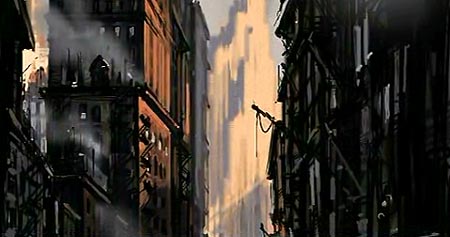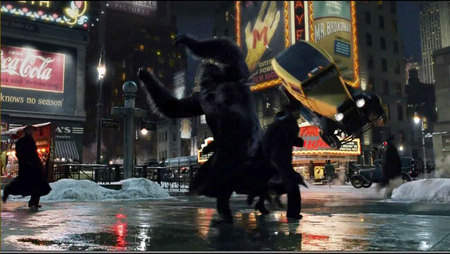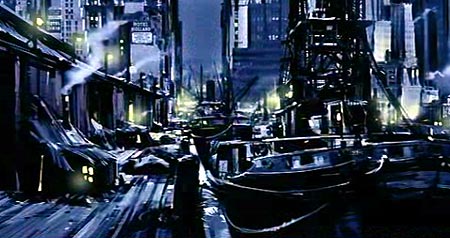Now wait for last year, again, or: how King Kong wiped my memory
Mon. January 2, 2006Categories: Abstract Dynamics

What’s the point in the first hour of King Kong?
Some may ask – and not without good reason – what’s the point in all three hours, but the sense of gratuitousness is at its most pressing in the opening part of the film. The ostensible answer – to ‘establish’ the characters so that there is someone for us to ‘identify’ with in the action sequences – is plainly unconvincing for the simple reason that the characters are pasteboard thin, no more filled out than their counterparts in the 1933 original. Jackson is not interested in characters, and what interest we viewers have in the film has little to do with characters either.
I suspect the real answer lies in the strange, necrophiliac impulse that presumably drove Jackson to remake the picture in the first place. That impulse leads to a cinema of the past that is no longer a cinema of History; a cinema of FX that leaves no traces.
In his classic analysis, Jameson identified a waning of the historical sense as a defining characteristic of the postmodern. The ‘nostalgia mode’ is evident, not so much in films whose content is backward-looking, but whose form belongs to the past. Thus an archetypal postmodern film such as Body Heat will be characterised by a tension between its contemporary setting (the 1980s) and its Noir form (which derives from the 30s/40s). The 1976 Kong remake, directed by John Guillermin at a time in which remakes were not so wearisomely ten-a-penny as they are today, corresponds to this model much more than does Jackson’s film. Neither the contemporary setting nor a post-Oil crisis plot involving a petroleum expedition can disguise the fact that the 76 version (undistinguished and rather boring as it was) runs on a 30s Adventure movie template.
Someone else’s memories…

Jackson’s film is something different again. It eliminates the tension between contemporaneity (setting) and the past (form as revenant) by ignoring the present altogether and setting the film in the year the original film was released, 1933. The result is a peculiar, slightly creepy, homage, which might well constitute a new type of postmodern arfifact altogether. The 21st century obtrudes into Jackson’s King Kong only in the form of technology. The implicit conceit is that this is the film that would have been made in 1933 were the technological means available at that time. FX are, naturally, the real stars of Jackson’s King Kong. (I need hardly point out that Jackson’s whole career as a film-maker, from the ecstactic mondo trash of his early features through to Lord of the Rings, rests on a mastery of special effects.) In King Kong, FX have replaced history. Or rather, ‘history’ – now flattened out into a series of period signifiers – has itself become a kind of special effect. (Technology substitutes not only for history but for culture, too; in 2005, technological progress is the only faith that remains to us.) Even if the simulation were note-perfect accurate, History, in the Marxist sense of struggle, antagonism and contingency, would still be photoshopped out. The Depression is a stage-set, an inexplicable backdrop. This a museum without History, the Past as Experience, Theme Park…
I’m reminded of Wash-35 in Dick’s Now Wait for Last Year, a ‘painstakingly elaborate reconstruction’ of Washington in 1935, built on Mars at the behest of a plutocrat who wants to walk through the city of his childhood again. ‘Here was Grammage’s, a shop at which Virgil had bought Tip Top comics and penny candy. Next to it Eric made out the People’s Drugstore; the old man during his childhood had bought a cigarette lighter here once and chemicals for his Gilbert Number Five glassblowing and chemistry set. “What’s the Uptown Theater showing this week?”‘
Yet there’s something touching about Wash-35 – according to Jameson it is one of ‘Dick’s most sublime inventions’ – whereas watching the simulations of 30s New York in the first few minutes of King Kong – from the opening Al Jolson number through to the Vaudeville routines and scenes of the Depression-hit poor – makes for an empty, if eerie, experience. Perhaps it’s because this is nostalgia for something that Jackson himself had never encountered, nostalgia for the context of a film he in any case would have only have seen decades after it had been released, that these scenes have a strange hollowness and depthlessness. It’s a nostalgia that is already thoroughly mediated, a replicant nostalgia, a nostalgia for someone else’s memories.

Someone else’s dream
There’s something homologous in the way that the film refuses to linger in the memory. Walking out of the cinema, I found myself unable to bring any images to mind. It felt like there was nothing to talk about, as if the film had instantly erased itself from the memory. No doubt that is because the most arresting sections of the film – the CGI action sequences – never enter visual memory at all. If the breakneck tactility of these sequences is retained, they are more likely to be stored in the body’s motor reflexes than in its visual or narrative memory.
Is such an immediate auto-erasure inherent to CGI, or is it because so many CGI-dominated films are devoted to high-speed action that CGI films typically leave so few traces? As I try to recall King Kong now, it is like attempting to bring to mind a dream, but a dream I never really had myself, someone else’s dream…
UPDATE:
1. Simon asks why did I bother seeing it at all? Partly what fascinated me was the discrepancy between the uniformly laudatory press the film has received here and the disdain expressed by I.T. and Savanorola after they saw it. Their view – that it was tedious, poorly edited and racist – bore no relation whatsoever to the standard media position that this was a well-made blockbuster. In addition, media hype is a kind of mind virus, a mental itch… and sometimes you have to scratch…
2. ‘[N]o one ever looked at a staggeringly mysterious sublime – but patchy – early Icon of some religious scene and said: Well, what’s wrong with this is that it isn’t REAL enough…’ Penman takes up the cudgels. I think a Baudrillardian AND a psychoanalytic critique of digital realism can be derived from Ian’s remarks here. It is important, though, to distinguish between the Real and the realistic, since this distinction is precisely what is lost in the pursuit of seamless CGI simulation. Nothing highlights the retreat of the Real under pressure from the realistic more than Kong. Here Baudrillard and Zizek would be in perfect harmony – realism imagines that the Real can be grasped head on, without residue or symbolic debt, whereas for them, it can never be apprehended directly, only anamorphically, out of the corner of the eye. The theatrical and the artificial, i.e. the very things collapsed in the name of realism, are therefore not properly opposed to the Real; they are the means by which the Real can be registered, the frames through which we can glean something of its contours. Kong is a film without the unconscious. It is as as odd, as pointless – and as autistically point-missing -, as if a particularly literal-minded individual had made a minutely observed, fastidiously reconstruction of someone else’s dream. Everything is lost in translation.
Catherine takes up the line about technology being our last remaining faith.